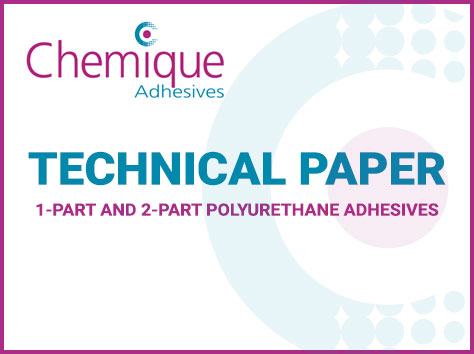1 Part And 2 Part Polyurethane Adhesives
The objective of this technical paper is to provide a background to 1-part (1K) and 2-part (2K) polyurethane adhesive systems

Chemistry Background
Polyurethane based adhesives are very versatile with good performance characteristics and they can be formulated to give a wide range of physical properties such as viscosity and application properties such as pot life. Polyurethane systems used for adhesives can be separated into two main classifications, these are the 1K (1-part) and 2K (2-part) systems with both sharing some similarities, and each has distinct advantages and disadvantages.
All polyurethane adhesives use the same chemical reaction as their base, this being a reaction between an isocyanate and a polyol. For 2K systems the isocyanate and the polyol will be manufactured and supplied as separate components. Mixing of the two components just prior to application to create the chemical reaction and fully cross-link the system will be required, to ensure this happens correctly an accurate ratio of components and sufficient mixing must be guaranteed.
Alternatively, with 1K systems during manufacture the polyol will be reacted with excess isocyanate such that the polyol chain is terminated with an isocyanate group. The ratio of isocyanate to polyol will help to determine the chain length of the terminated polyurethane prepolymer. This polyurethane prepolymer becomes the reactive component of the 1K system.
To complete the reaction a 1K system will need to interact with water to fully cross-link. A chemical reaction occurs between the isocyanate on the end of prepolymer chains of a 1K system and water that result in a polyurea linkage. This means that water needs to be present for a 1K system to cross-link and this can be from moisture in the atmosphere, however, for some adhesives this will be from the application of a water mist prior to the addition of the second substrate being bonded. Alternatively, the prepolymer may be dissolved in a solvent carrier and the prepolymer will react with moisture as the solvent evaporates.
Advantages and Limitations
Polyurethane adhesives of both classifications (1K and 2K) share some advantages and limitations.
Advantages of polyurethane based adhesives include:
• The cure time and pot life can be varied through formulation changes
• Good flexibility can be achieved in the cured product
• Good resistance to solvents when cured
• Excellent adhesion to a wide range of substrates
• Depending on the formulation polyurethane adhesives have a moderate cost
• Can be applied using multiple methods – roller, brush, spray and these can be automatic or manual
• Polyurethane adhesives are non-flammable
• Although they can be solvented, they can also be supplied solvent free
• Heat is not required for cure but can be used to speed up the cure once both substrates are present
• Can stay bonded through a wide range of operating temperatures
Limitations of polyurethane based adhesives include:
• Uncured material is sensitive to moisture
• Although they adhere to most substrates some substrates may require a primer for the polyurethane based adhesive to adhere
• May have short shelf life, generally shelf life is 3-12 months for both 1K and 2K adhesives
• Due to the formation of carbon dioxide which can cause foaming, assemblies made using polyurethane adhesives may need to be held in a press under sufficient pressure whilst the adhesive cures to stop this occurring
Due to the way in which the adhesive is supplied and the formation of urea linkages when curing, 1K adhesives will have some additional advantages:
• No mixing is required
• Easy to apply
• Excellent chemical resistance
• Can be either solvented or solvent free depending on the application required
They will also have some additional limitations:
• Cure time and pot life will be very dependent on the ambient conditions
• Due to the moisture cured nature of the material, once the container is open it will start to react with moisture in the air shortening its shelf life and increasing its viscosity
• Requires sufficient moisture to fully cure, this may mean appropriate level of water misting before application of the second substrate
As there are additional advantages and limitations of 1K polyurethane adhesives, this also applies with 2K adhesives and the advantages of 2K adhesives include:
• Generally longer shelf lives than 1K polyurethane adhesives
• Cure time more dependent on formulation rather than ambient conditions
• No additional processes (e.g. water-misting) required after application of adhesive
Limitations of 2K polyurethane based adhesives include:
• Correct ratio of components is required to properly cure the adhesive
• Sufficient mixing of the two components before application is required
Troubleshooting
The issues that most often arise with polyurethane adhesives are usually due to one of the following reasons:
• Using an adhesive with a pot life that is too short for the conditions, such that the substrates are not assembled and under pressure within the pot life
• Insufficient adhesive applied to substrate so there is not enough coverage to give a complete bond. If one of the substrates is porous this must be taken into account, as should the uniformity of the surface.
• For 1K systems if water misting is required, there is not enough water misting to allow the reaction to fully take place. This is suggested to be 7-10% of the adhesive applied.
• Not enough pressure within the press. Total surface area of substrate needs to be considered, such that the pressure is approximately 10psi.
Conclusions
Polyurethane based adhesives can be formulated to give a wide range of properties that enable them to adhere to many substrates. There are many advantages to using them as well as a few limitations which must also be considered.
CONTACT
Clive Robson
Chemique Adhesives & Sealants Ltd
enquiries@chemiqueadhesives.com
www.chemiqueadhesives.com
+44 1922 459321
Thursday 20 August 2020 / file under Aerospace | Automotive | Construction | Engineering | Marine



